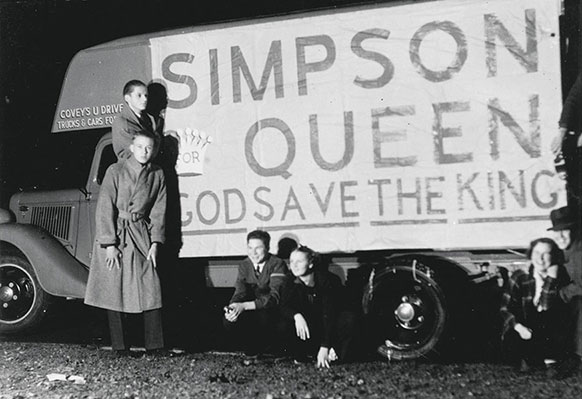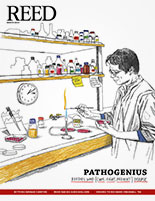
IRIS login | Reed College home Volume 92, No. 1: March 2013
Apocrypha: Traditions, Myths, & Legends
Simpson for Queen!

Reed students (including Helen Branigin ’40 , Angus Crawford ’40, and Arthur Livermore ’40) commandeered a truck for the Simpson For Queen stunt of October 1936. President Dexter Keezer was reportedly not amused.
Photo by David Livermore ‘45
By Raymond Rendleman ’06
The black-tie political dinner in the Commons held October 30, 1936, promised to be an elegant and provocative affair.
Seat cards announced tables for Democrats, Republicans, Socialists, Unionists, Communists, and Mugwumps (for students who eschewed party labels). George Read ’39, chairman of the political dinner, invited five well-known representatives of Oregon’s political spectrum, including Republican U.S. Congressman William A. Ekwall and his Democratic challenger, Nan Wood Honeyman (who would unseat Ekwall in the election four days later). In the depths of the Great Depression, the dinner would provide an open forum for the leading political issues of the day, held in classic Reed style. In advertisements for the dinner, George wrote, “Heckling of the speakers, in accordance with time-honored tradition, will be permitted.”
But halfway through the dinner, George’s well-laid plans unraveled. A bunch of Reedies burst through the doors waving huge, yellow, butcher-paper signs proclaiming “Simpson for Queen—God Save the King.”
The signs referred to the crisis then gripping the United Kingdom as King Edward VIII sought a way out of the dilemma posed by his love for Mrs. Wallis Simpson, an American socialite with two living ex-husbands.
Arriving at the scene of the dinner to make some sense of the ruckus was a man introduced as “Dr. Myron K. Blackstone,” allegedly a fellow of the “North American Institute for Political Research.” Sharp-eyed diners recognized Dr. Blackstone as Lamar Holt ’40, disguised under a fake beard and glasses that would have made Groucho Marx blush.
Cutting someone else’s speech short, Dr. Blackstone announced, “I offer to you, the first audience in the world, the program and the platform for an entirely new political party . . . Regardless of who gets in the White House, we want an American in Buckingham Palace. Mrs. Simpson for Queen!”
“God save the King!” shouted confederates sprinkled around the room. Then about 20 members of the newly formed “Reed College International Chapter No. 1 of the Simpson for Queen Committee” rushed out of the Commons, piled into a rented Covey truck, and cruised Broadway several times every evening until the election, playing trumpets and making stump speeches. Dr. Blackstone, Mrs. Simpson, and Edward VIII were the most popular Halloween costumes at Reed that year.
Alumni from the period fondly remember the prank, although it was almost lost to history. “The boom to extend American influence to Buckingham Palace came as a hilarious surprise to all but a few participants,” reported the Oregonian in a two-sentence mention on November 1, 1936. Time magazine gave the event eight sentences, although editors of the British edition, in an apparent effort to shield the Crown, redacted the piece but ran the accompanying photograph snapped by David Livermore ’45 using a big Graflex camera. Six students are visible, standing proudly or beaming in front of the truck, including Helen Branigin ’40,, Angus Crawford ’40, and Arthur Livermore ’40.
Reed’s waggish president, Dexter Keezer [president 1934–42], wasn’t too keen on such activity, recalls Ethel Noble ’40. “He would always say, ‘You’re free to do all these demonstrations, but not in the name of Reed College,’ yet somehow we were well-known around town as Reedies,” she said.
Ethel added that the wacky costumes made it clear that the rallies were simply in jest, but Earnest Movius ’37 and Lee Charette ’39 recalled a serious motivation to make light of Reed’s reputation as a “red” school and poke fun at conservatives’ overblown reaction to the Simpson scandal, which was finally resolved on December 10, 1936, when Edward VIII abdicated. (Public displays of affection were rare in 1936; Enny Schulz ’40 recalled that the king’s announcement was the first time she had ever heard a man publicly state he loved a woman.)
“It was a prank with a meaningful, down-to-earth philosophy behind it,” Earnest said.


LATEST COMMENTS
steve-jobs-1976 I knew Steve Jobs when he was on the second floor of Quincy. (Fall...
Utnapishtim - 2 weeks ago
Prof. Mason Drukman [political science 1964–70] This is gold, pure gold. God bless, Prof. Drukman.
puredog - 1 month ago
virginia-davis-1965 Such a good friend & compatriot in the day of Satyricon...
czarchasm - 4 months ago
John Peara Baba 1990 John died of a broken heart from losing his mom and then his...
kodachrome - 7 months ago
Carol Sawyer 1962 Who wrote this obit? I'm writing something about Carol Sawyer...
MsLaurie Pepper - 8 months ago
William W. Wissman MAT 1969 ...and THREE sisters. Sabra, the oldest, Mary, the middle, and...
riclf - 10 months ago